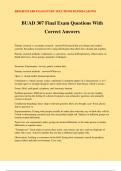BRIGHTSTARS EXAM STUDY SOLUTIONS 8/15/2024 2:05 PM
BUAD 307 Final Exam Questions With
Correct Answers
Primary research vs secondary research - answer✔✔research that you design and conduct
yourself. Secondary research involves using information that others have already put together.
Primary research methods: exploratory vs. precision - answer✔✔Exploratory: Observation, in-
depth interviews, focus groups, projective techniques
Precision: Experiments, surveys, panel, scanner data
Primary research methods - answer✔✔Surveys
Open vs. closed-ended: planned questions
Continuum vs. binary answer scales: continuum is rating the degree of a characteristic (1 to 5,
strongly agree or strongly disagree) and is much more effective than binary, which is yes/no
Forms: Mail, mail panel, telephone, mail intercept, internet
Problem questions: Difficult to answer (knowledge needed), sensitive, two in one, leading
questions (giving the feeling of a desired response), non-exhaustive question, non-mutually
exclusive answers
Conditional branching: direct skip to relevant question. Have you bought a car? If not, please
skip to question 11.
Experimentation: Testing what people actually do rather than what they say or think they will do.
Useful in determining causation and why one product might sell. Subjects in different groups are
usually treated differently.
Taste tests: not experiments unless groups are treated differently or the same person is treated
differently at separate times.
"Triangle test": Each subject is given three items: one current, one new, and one duplicate of
either old or new. Asked to identify the one that is different and explain why.
Observation: Looking at consumers in the field. Seeing how consumers search for products,
inspect labels and their involvement. Costs vary.
, BRIGHTSTARS EXAM STUDY SOLUTIONS 8/15/2024 2:05 PM
Focus groups: Groups 5-12 assemble to talk generally about context of product, then gradually
"focus" in on actual product. Costs are high and is only an early stage method.
In-depth interviews: Structured or unstructured, useful for contrasting types of consumers who
would buy product, and useful for highly emotion or identity involved products such as cars, and
there are biases. Costs are extremely high.
Projective techniques: Getting at motivations which may not be consciously known. This is to
find out the hidden attitudes of consumers that they may not be
"Big data and a big bear" - answer✔✔firms have drastically increased their use of data mining
and use of "big data," which is their statistical analysis of their consumers and how they behave.
This gives information on consumer opinions, usage, when they might stop using products, and
how products might sell in the future.
Syndicated secondary data - answer✔✔this is data purchased for a fee from commercial research
firms. Secondary data often comes from census reports, reports, scanner data, and panel data.
Internal secondary data - answer✔✔this is secondary data gathered within a firm. Many firms
can access a cache of customer information and purchase history, and can utilize data mining and
big data of their consumers.
"Selfies as data" - answer✔✔companies have started using facial recognition and biometric data
to record consumer behavior. This can be used to gauge consumer reaction to advertisements or
products.
Segmentation - answer✔✔dividing prospective buyers into groups who have common needs and
buying patterns.
Dynamic pricing - answer✔✔price is set based on past behavior of customer
Targeting: process and approaches - answer✔✔selecting segments and specializing.
Process: criteria involves identifiability (distinctiveness of segment), reachability, substantiality,
profitability, and responsiveness
Approaches: undifferentiated (everyone), differentiated (several segments), concentrated (one
segment), micro-marketing (unique to each customer)
The merge-purge process - answer✔✔combining of different sources (often catalogs or
magazine subscription lists) to create segments. The sources are added together (merged), then
overlap and duplicates are removed (purged). This increases the number of individuals, not
necessarily the information.




